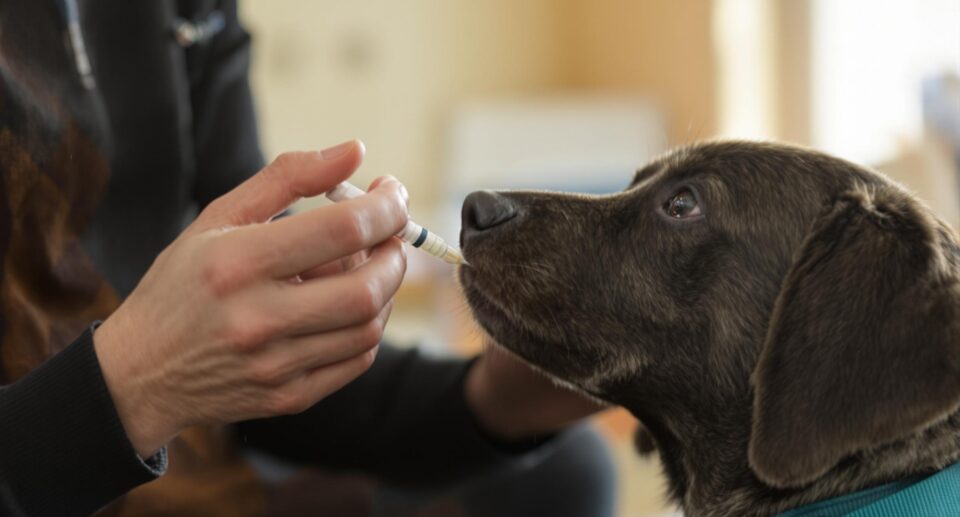How To Give Your Dog Insulin
- 5 Min Read

-
As the driving force behind PetHealthMD, the PetMeds.com Editors team is your trusted source for reliable, expert-backed insights on pet health and wellness. With an unwavering commitment to enhancing the lives of pets at every stage, we have guided over 11 million pet parents in making informed decisions that lead to happier, healthier lives for their beloved animals.
View all posts
Most pet parents are nervous about giving their dog or cat insulin at home for the first time. Diabetes is very common in dogs and cats, affecting about 1 in 300 veterinary patients. Though you will go through a learning curve as you get the hang of managing their diabetes, with the right support, knowledge, and tools, you can enjoy many more healthy years with your four-legged family member.
What You’ll Need
Your veterinarian will likely give you a list of supplies you’ll need when your pet is diagnosed. Generally, you’ll be advised to get a glucose monitoring system like AlphaTrak 2 or iPet Pro.
You can also use a urine strip test kit to regularly check your pet’s urine for high levels of ketones, which indicates diabetic ketoacidosis. If your pet is not receiving enough insulin, and their blood sugar is too high, their blood can become too acidic. Diabetic ketoacidosis is life-threatening and requires immediate veterinary attention.
If more than one household member will be caring for your pet, it’s crucial that there are no miscommunications about your pet’s schedule. It’s helpful to use a journal, a phone app, or a dry erase board to track meals and insulin dosages.
Your pet’s insulin should be stored in your refrigerator. It should never be placed in the door of the refrigerator where the temperature can fluctuate. Most pet parents store it in a bottom shelf or near the back of the fridge, in its box protected from light.
There are different types of syringes, so make sure you purchase the right kind to avoid dosing your pet incorrectly. U-40 syringes are most commonly used for pets, while U-100 are more often used for human insulin, which has a higher concentration of units per mL. If you buy the wrong type, you will need to convert your pet’s dose to ensure you’re filling to the correct mark on the syringe. Talk to your vet if you need help calculating your pet’s dose.
You’ll also need a sharps container in which to safely dispose of used syringes and other medical waste. Many pet parents use a clean laundry detergent jug that has a cap. When its full, you can drop the container off at your vet’s office or a medical waste disposal center.
Insulin and Your Pet’s Feeding Schedule
You should always feed your pet before you give them insulin. If you give insulin first, and feed your pet afterwards, there is always a chance that they may decide not to eat. When your pet gets insulin but does not eat, their blood sugar can become dangerously low. Seek emergency veterinary care if this does occur.
Pet parents with enthusiastic eaters can sometimes inject their pet while they’re mid-meal. If you’re unsure if your pet will finish their food, though, you’ll need to be able to adjust their dosage accordingly.
It’s generally best to give your pet two meals a day about 12 hours apart. Each meal should be roughly the same in terms of calories and serving size. Your pet can have low-carb between-meal snacks like fresh, raw or steamed veggies, and you can use small portions of their meals as training treats. Purebites freeze-dried chicken treats are made from 100% chicken, so they’re a favorite of pet parents managing diabetes. Always talk to your vet before making changes to your pet’s diet or trying a new treat.
How To Administer Insulin
Insulin is administered with a thin needle, so injections should be nearly painless. For pets that struggle or lash out, being constrained can be more stressful than the injection itself. Administering the injection swiftly and confidently will make the experience more tolerable for your stressed pet.
First, gather everything you need so you won’t have to fumble with a squirming animal in your arms. Then, feed your pet. Wash your hands.
Take the insulin out of the refrigerator and gently rock it back and forth to mix. Do not shake it, as doing so creates air bubbles and degrades its effectiveness. The exception to this is Vetsulin; it needs to be shaken thoroughly.
Unwrap a fresh new syringe and remove the protective cap from the needle. Invert the insulin. Insert the needle into the rubber stopper, then pull back the plunger just past your pet’s prescribed dose. Flick the syringe to draw any air bubbles to the top, then push the plunger to your pet’s dose. Some pet parents prefer VetPen, an automatic insulin delivery pen that makes giving your pet insulin injections faster and easier.
Tent your pet’s skin at the injection site. You may inject at your pet’s scruff, between their shoulder blades, alternating between shoulders, or near either hip bone. Your vet can show you appropriate injection sites if you’re unsure.
Inject the needle at the pocket of skin you’ve created at the center of the skin tent, taking care not to allow the needle to come out the opposite side. Depress the plunger to administer the full dose.
Dispose of the syringe in a sharps container.
Tips For Minimizing Stress
While receiving an insulin injection is not very painful, it can be uncomfortable for nervous pets. You can minimize discomfort by alternating injection sites. Warm the barrel of the syringe in your hands to warm up the insulin before injecting. Do not rub the site after the injection.
Always follow your veterinarian’s advice, even if it contradicts these instructions, as all diabetic pets have different needs. If you’re struggling to administer insulin, do not hesitate to bring your pet to your vet for help. Some pet parents need more than one demonstration before they feel confident enough to do it alone.





